roof rack FORD BRONCO 2023 Owners Manual
[x] Cancel search | Manufacturer: FORD, Model Year: 2023, Model line: BRONCO, Model: FORD BRONCO 2023Pages: 642, PDF Size: 14.71 MB
Page 14 of 642
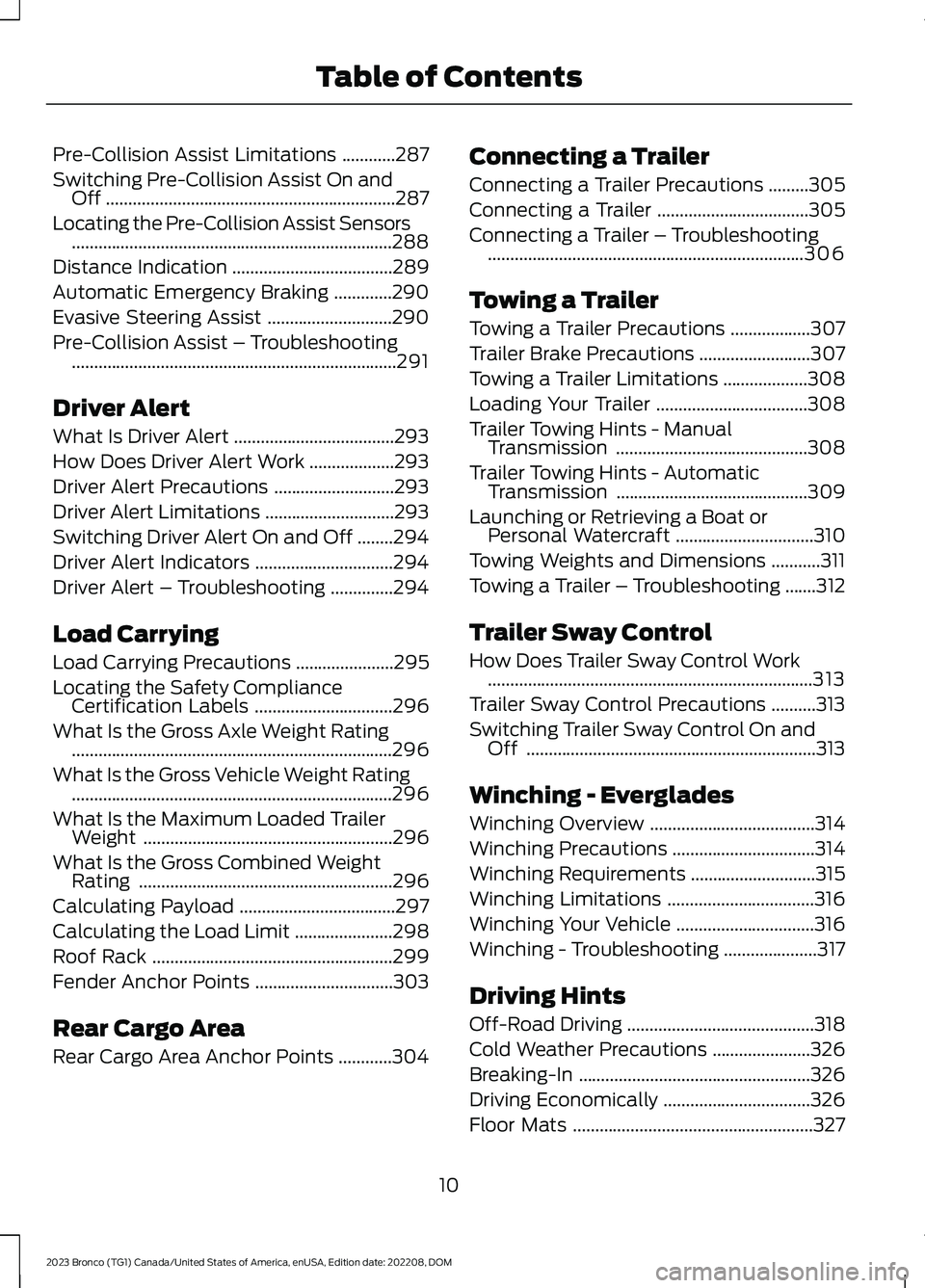
Pre-Collision Assist Limitations............287
Switching Pre-Collision Assist On andOff.................................................................287
Locating the Pre-Collision Assist Sensors........................................................................288
Distance Indication....................................289
Automatic Emergency Braking.............290
Evasive Steering Assist............................290
Pre-Collision Assist – Troubleshooting.........................................................................291
Driver Alert
What Is Driver Alert....................................293
How Does Driver Alert Work...................293
Driver Alert Precautions...........................293
Driver Alert Limitations.............................293
Switching Driver Alert On and Off........294
Driver Alert Indicators...............................294
Driver Alert – Troubleshooting..............294
Load Carrying
Load Carrying Precautions......................295
Locating the Safety ComplianceCertification Labels...............................296
What Is the Gross Axle Weight Rating........................................................................296
What Is the Gross Vehicle Weight Rating........................................................................296
What Is the Maximum Loaded TrailerWeight........................................................296
What Is the Gross Combined WeightRating.........................................................296
Calculating Payload...................................297
Calculating the Load Limit......................298
Roof Rack......................................................299
Fender Anchor Points...............................303
Rear Cargo Area
Rear Cargo Area Anchor Points............304
Connecting a Trailer
Connecting a Trailer Precautions.........305
Connecting a Trailer..................................305
Connecting a Trailer – Troubleshooting.......................................................................306
Towing a Trailer
Towing a Trailer Precautions..................307
Trailer Brake Precautions.........................307
Towing a Trailer Limitations...................308
Loading Your Trailer..................................308
Trailer Towing Hints - ManualTransmission...........................................308
Trailer Towing Hints - AutomaticTransmission...........................................309
Launching or Retrieving a Boat orPersonal Watercraft...............................310
Towing Weights and Dimensions...........311
Towing a Trailer – Troubleshooting.......312
Trailer Sway Control
How Does Trailer Sway Control Work.........................................................................313
Trailer Sway Control Precautions..........313
Switching Trailer Sway Control On andOff.................................................................313
Winching - Everglades
Winching Overview.....................................314
Winching Precautions................................314
Winching Requirements............................315
Winching Limitations.................................316
Winching Your Vehicle...............................316
Winching - Troubleshooting.....................317
Driving Hints
Off-Road Driving..........................................318
Cold Weather Precautions......................326
Breaking-In....................................................326
Driving Economically.................................326
Floor Mats......................................................327
10
2023 Bronco (TG1) Canada/United States of America, enUSA, Edition date: 202208, DOMTable of Contents
Page 223 of 642
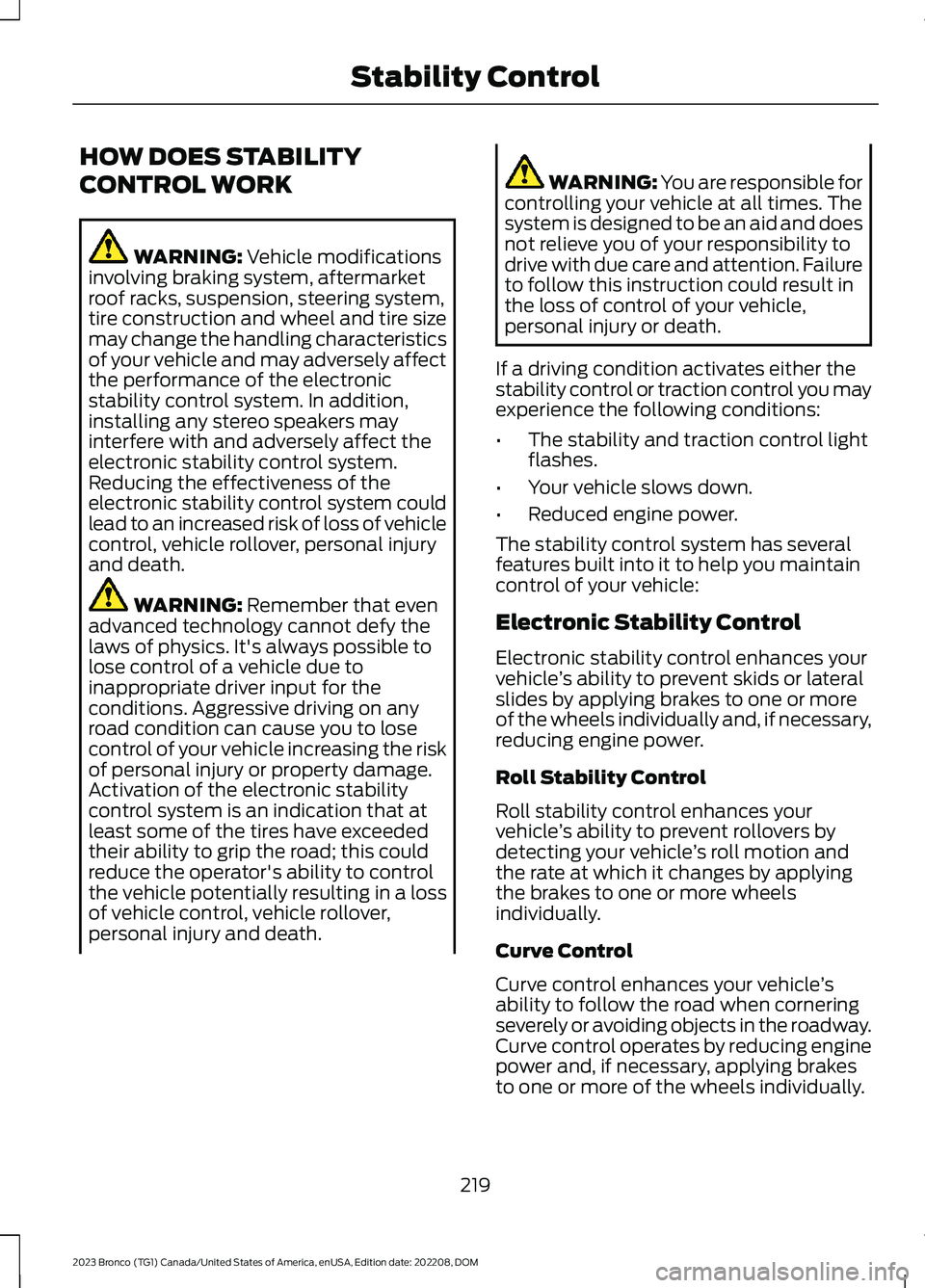
HOW DOES STABILITY
CONTROL WORK
WARNING: Vehicle modificationsinvolving braking system, aftermarketroof racks, suspension, steering system,tire construction and wheel and tire sizemay change the handling characteristicsof your vehicle and may adversely affectthe performance of the electronicstability control system. In addition,installing any stereo speakers mayinterfere with and adversely affect theelectronic stability control system.Reducing the effectiveness of theelectronic stability control system couldlead to an increased risk of loss of vehiclecontrol, vehicle rollover, personal injuryand death.
WARNING: Remember that evenadvanced technology cannot defy thelaws of physics. It's always possible tolose control of a vehicle due toinappropriate driver input for theconditions. Aggressive driving on anyroad condition can cause you to losecontrol of your vehicle increasing the riskof personal injury or property damage.Activation of the electronic stabilitycontrol system is an indication that atleast some of the tires have exceededtheir ability to grip the road; this couldreduce the operator's ability to controlthe vehicle potentially resulting in a lossof vehicle control, vehicle rollover,personal injury and death.
WARNING: You are responsible forcontrolling your vehicle at all times. Thesystem is designed to be an aid and doesnot relieve you of your responsibility todrive with due care and attention. Failureto follow this instruction could result inthe loss of control of your vehicle,personal injury or death.
If a driving condition activates either thestability control or traction control you mayexperience the following conditions:
•The stability and traction control lightflashes.
•Your vehicle slows down.
•Reduced engine power.
The stability control system has severalfeatures built into it to help you maintaincontrol of your vehicle:
Electronic Stability Control
Electronic stability control enhances yourvehicle’s ability to prevent skids or lateralslides by applying brakes to one or moreof the wheels individually and, if necessary,reducing engine power.
Roll Stability Control
Roll stability control enhances yourvehicle’s ability to prevent rollovers bydetecting your vehicle’s roll motion andthe rate at which it changes by applyingthe brakes to one or more wheelsindividually.
Curve Control
Curve control enhances your vehicle’sability to follow the road when corneringseverely or avoiding objects in the roadway.Curve control operates by reducing enginepower and, if necessary, applying brakesto one or more of the wheels individually.
219
2023 Bronco (TG1) Canada/United States of America, enUSA, Edition date: 202208, DOMStability Control
Page 299 of 642
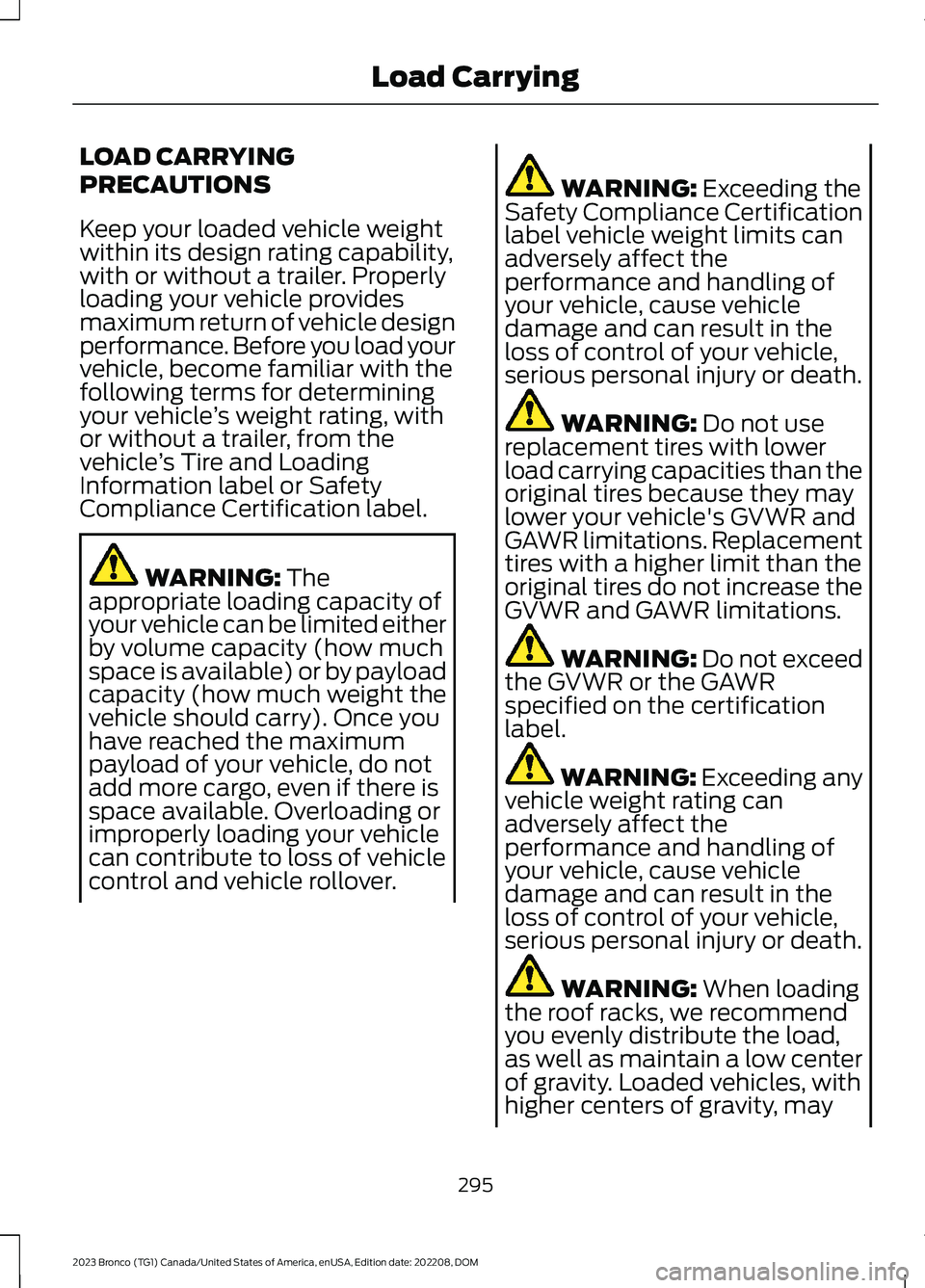
LOAD CARRYING
PRECAUTIONS
Keep your loaded vehicle weightwithin its design rating capability,with or without a trailer. Properlyloading your vehicle providesmaximum return of vehicle designperformance. Before you load yourvehicle, become familiar with thefollowing terms for determiningyour vehicle’s weight rating, withor without a trailer, from thevehicle’s Tire and LoadingInformation label or SafetyCompliance Certification label.
WARNING: Theappropriate loading capacity ofyour vehicle can be limited eitherby volume capacity (how muchspace is available) or by payloadcapacity (how much weight thevehicle should carry). Once youhave reached the maximumpayload of your vehicle, do notadd more cargo, even if there isspace available. Overloading orimproperly loading your vehiclecan contribute to loss of vehiclecontrol and vehicle rollover.
WARNING: Exceeding theSafety Compliance Certificationlabel vehicle weight limits canadversely affect theperformance and handling ofyour vehicle, cause vehicledamage and can result in theloss of control of your vehicle,serious personal injury or death.
WARNING: Do not usereplacement tires with lowerload carrying capacities than theoriginal tires because they maylower your vehicle's GVWR andGAWR limitations. Replacementtires with a higher limit than theoriginal tires do not increase theGVWR and GAWR limitations.
WARNING: Do not exceedthe GVWR or the GAWRspecified on the certificationlabel.
WARNING: Exceeding anyvehicle weight rating canadversely affect theperformance and handling ofyour vehicle, cause vehicledamage and can result in theloss of control of your vehicle,serious personal injury or death.
WARNING: When loadingthe roof racks, we recommendyou evenly distribute the load,as well as maintain a low centerof gravity. Loaded vehicles, withhigher centers of gravity, may
295
2023 Bronco (TG1) Canada/United States of America, enUSA, Edition date: 202208, DOMLoad Carrying
Page 303 of 642
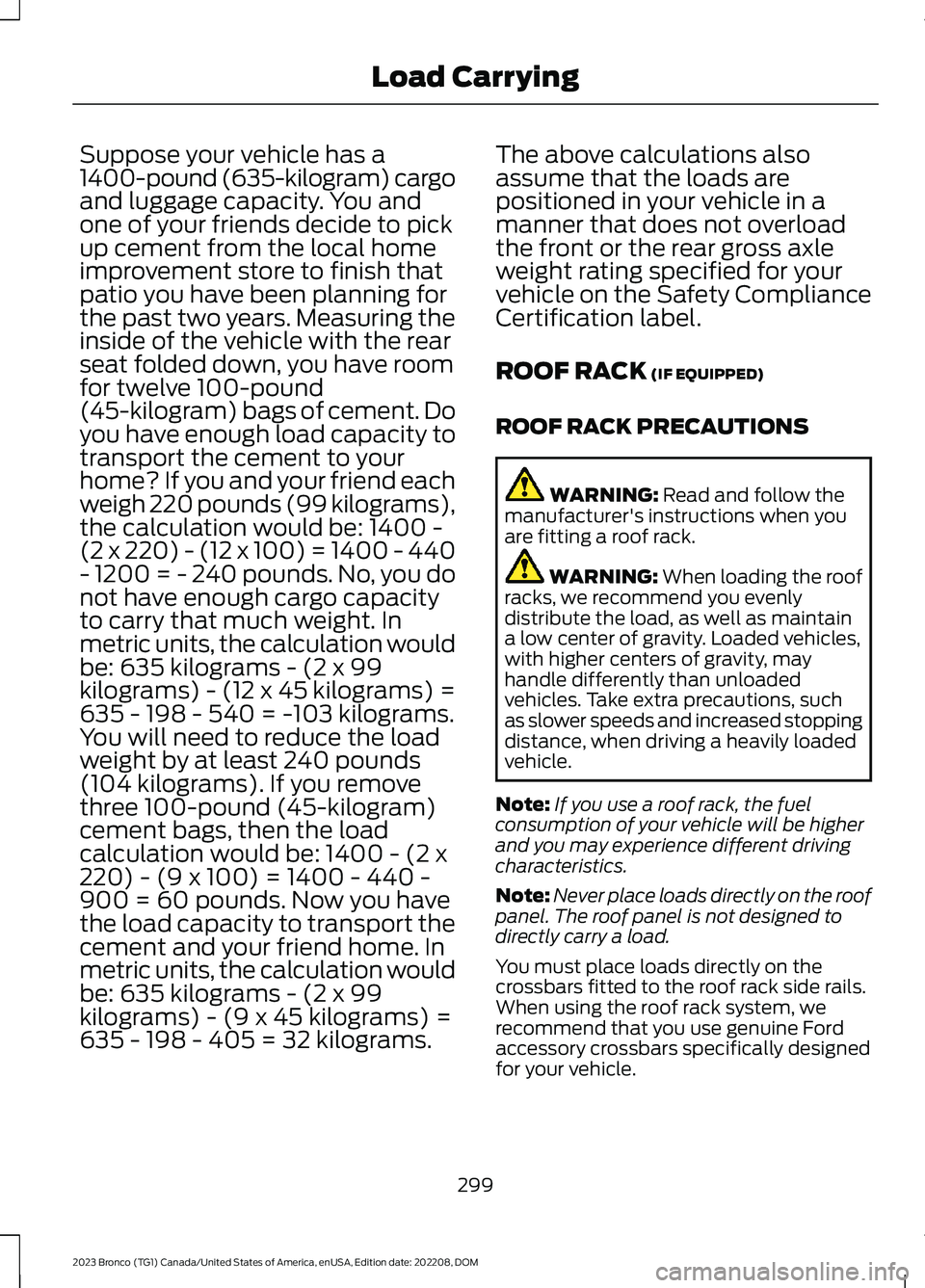
Suppose your vehicle has a1400-pound (635-kilogram) cargoand luggage capacity. You andone of your friends decide to pickup cement from the local homeimprovement store to finish thatpatio you have been planning forthe past two years. Measuring theinside of the vehicle with the rearseat folded down, you have roomfor twelve 100-pound(45-kilogram) bags of cement. Doyou have enough load capacity totransport the cement to yourhome? If you and your friend eachweigh 220 pounds (99 kilograms),the calculation would be: 1400 -(2 x 220) - (12 x 100) = 1400 - 440- 1200 = - 240 pounds. No, you donot have enough cargo capacityto carry that much weight. Inmetric units, the calculation wouldbe: 635 kilograms - (2 x 99kilograms) - (12 x 45 kilograms) =635 - 198 - 540 = -103 kilograms.You will need to reduce the loadweight by at least 240 pounds(104 kilograms). If you removethree 100-pound (45-kilogram)cement bags, then the loadcalculation would be: 1400 - (2 x220) - (9 x 100) = 1400 - 440 -900 = 60 pounds. Now you havethe load capacity to transport thecement and your friend home. Inmetric units, the calculation wouldbe: 635 kilograms - (2 x 99kilograms) - (9 x 45 kilograms) =635 - 198 - 405 = 32 kilograms.
The above calculations alsoassume that the loads arepositioned in your vehicle in amanner that does not overloadthe front or the rear gross axleweight rating specified for yourvehicle on the Safety ComplianceCertification label.
ROOF RACK (IF EQUIPPED)
ROOF RACK PRECAUTIONS
WARNING: Read and follow themanufacturer's instructions when youare fitting a roof rack.
WARNING: When loading the roofracks, we recommend you evenlydistribute the load, as well as maintaina low center of gravity. Loaded vehicles,with higher centers of gravity, mayhandle differently than unloadedvehicles. Take extra precautions, suchas slower speeds and increased stoppingdistance, when driving a heavily loadedvehicle.
Note:If you use a roof rack, the fuelconsumption of your vehicle will be higherand you may experience different drivingcharacteristics.
Note:Never place loads directly on the roofpanel. The roof panel is not designed todirectly carry a load.
You must place loads directly on thecrossbars fitted to the roof rack side rails.When using the roof rack system, werecommend that you use genuine Fordaccessory crossbars specifically designedfor your vehicle.
299
2023 Bronco (TG1) Canada/United States of America, enUSA, Edition date: 202208, DOMLoad Carrying
Page 304 of 642
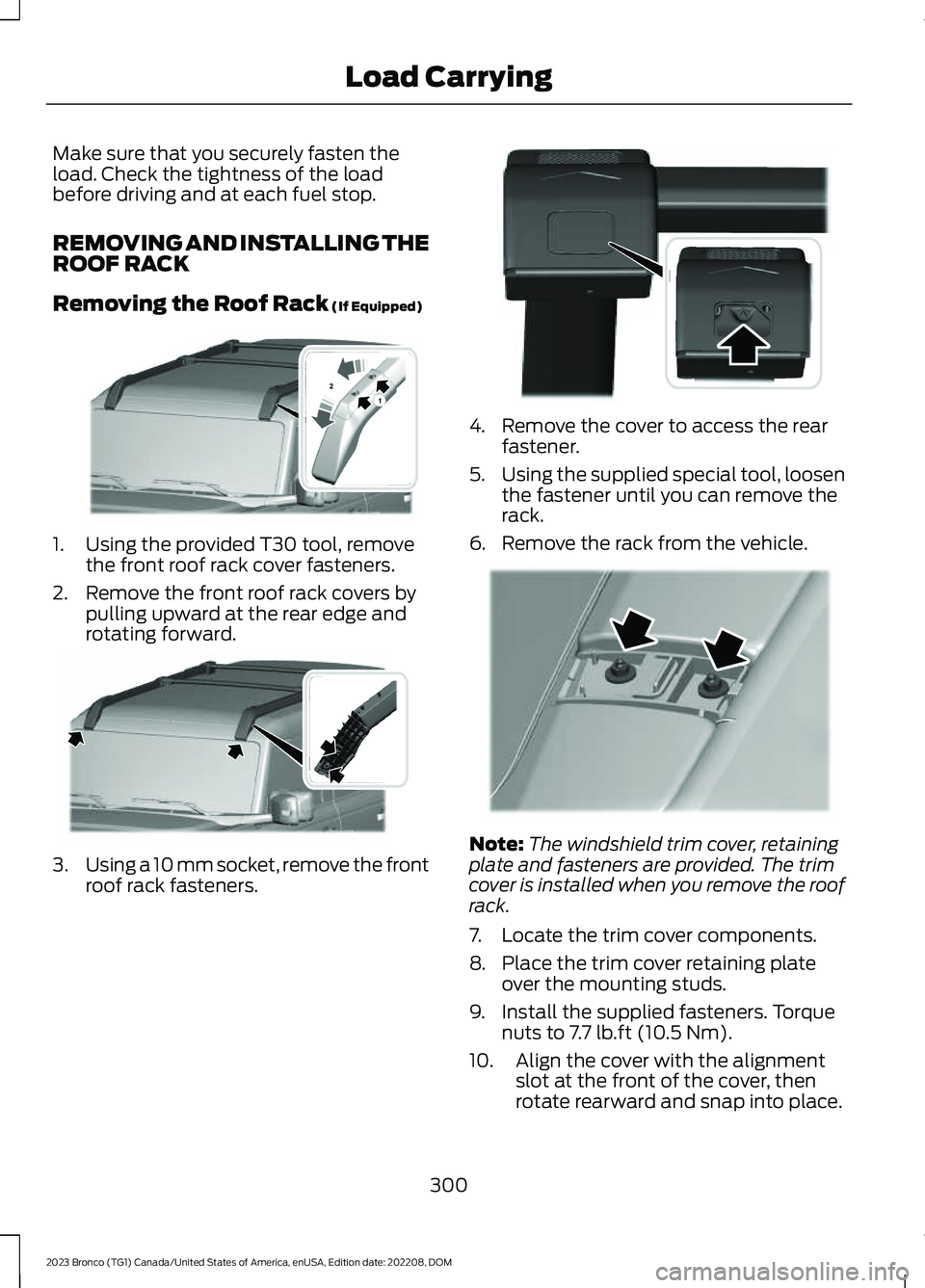
Make sure that you securely fasten theload. Check the tightness of the loadbefore driving and at each fuel stop.
REMOVING AND INSTALLING THEROOF RACK
Removing the Roof Rack (If Equipped)
1.Using the provided T30 tool, removethe front roof rack cover fasteners.
2.Remove the front roof rack covers bypulling upward at the rear edge androtating forward.
3.Using a 10 mm socket, remove the frontroof rack fasteners.
4.Remove the cover to access the rearfastener.
5.Using the supplied special tool, loosenthe fastener until you can remove therack.
6.Remove the rack from the vehicle.
Note:The windshield trim cover, retainingplate and fasteners are provided. The trimcover is installed when you remove the roofrack.
7.Locate the trim cover components.
8.Place the trim cover retaining plateover the mounting studs.
9.Install the supplied fasteners. Torquenuts to 7.7 lb.ft (10.5 Nm).
10.Align the cover with the alignmentslot at the front of the cover, thenrotate rearward and snap into place.
300
2023 Bronco (TG1) Canada/United States of America, enUSA, Edition date: 202208, DOMLoad Carrying12E339405 E339073 E339074 E339407
Page 305 of 642
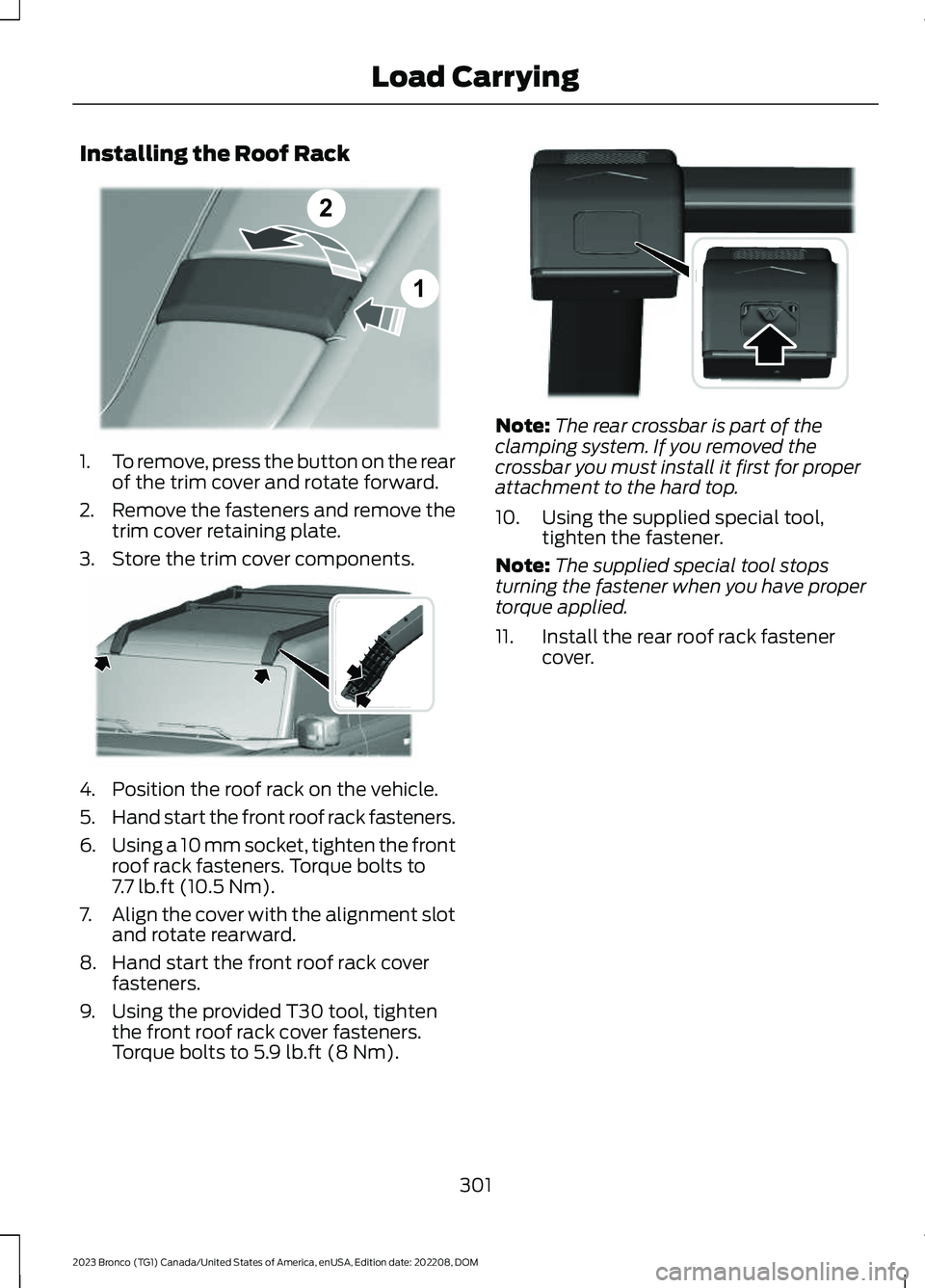
Installing the Roof Rack
1.To remove, press the button on the rearof the trim cover and rotate forward.
2.Remove the fasteners and remove thetrim cover retaining plate.
3.Store the trim cover components.
4.Position the roof rack on the vehicle.
5.Hand start the front roof rack fasteners.
6.Using a 10 mm socket, tighten the frontroof rack fasteners. Torque bolts to7.7 lb.ft (10.5 Nm).
7.Align the cover with the alignment slotand rotate rearward.
8.Hand start the front roof rack coverfasteners.
9.Using the provided T30 tool, tightenthe front roof rack cover fasteners.Torque bolts to 5.9 lb.ft (8 Nm).
Note:The rear crossbar is part of theclamping system. If you removed thecrossbar you must install it first for properattachment to the hard top.
10.Using the supplied special tool,tighten the fastener.
Note:The supplied special tool stopsturning the fastener when you have propertorque applied.
11.Install the rear roof rack fastenercover.
301
2023 Bronco (TG1) Canada/United States of America, enUSA, Edition date: 202208, DOMLoad Carrying12E339406 E339073 E339074
Page 306 of 642
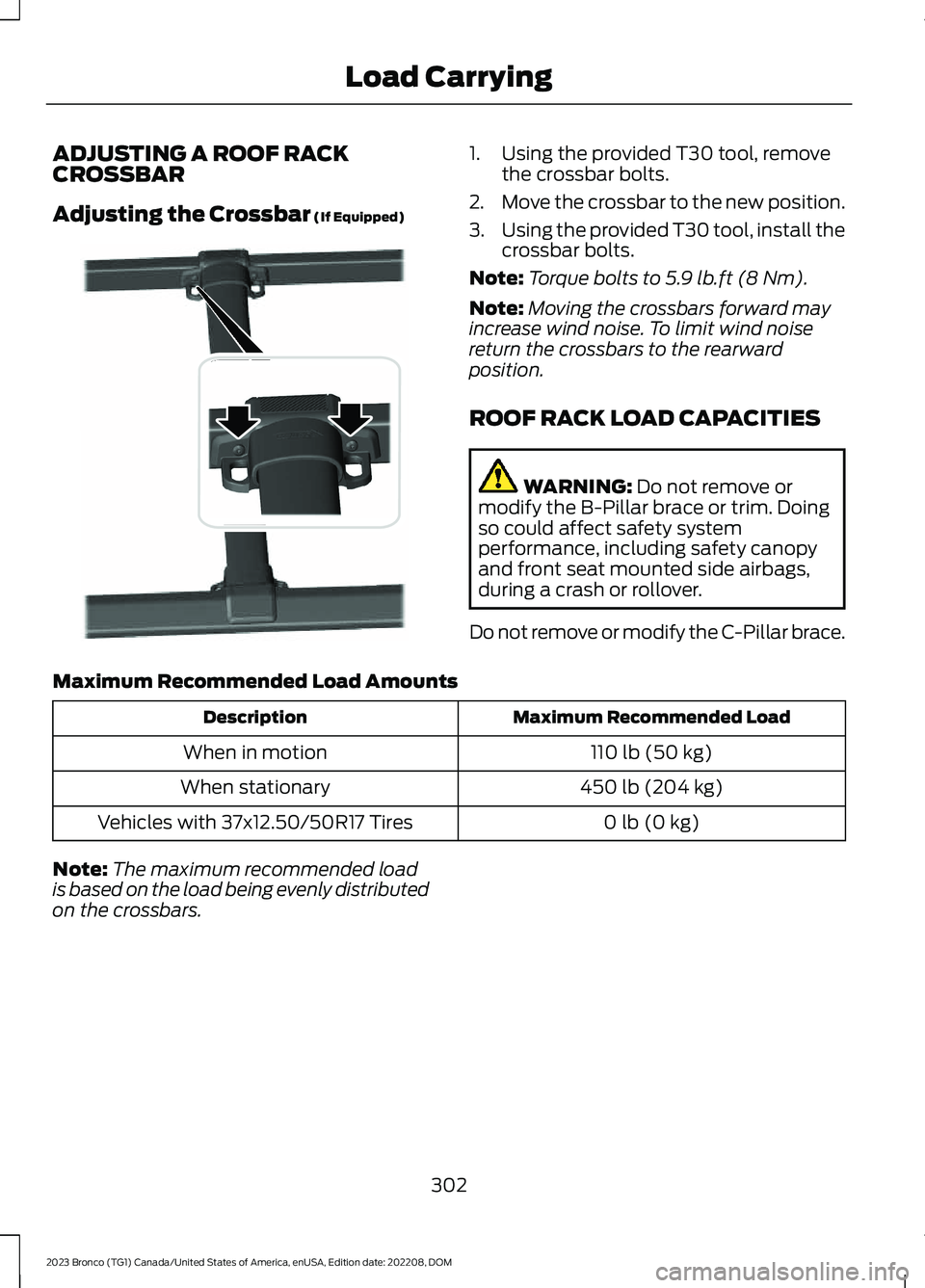
ADJUSTING A ROOF RACKCROSSBAR
Adjusting the Crossbar (If Equipped)
1.Using the provided T30 tool, removethe crossbar bolts.
2.Move the crossbar to the new position.
3.Using the provided T30 tool, install thecrossbar bolts.
Note:Torque bolts to 5.9 lb.ft (8 Nm).
Note:Moving the crossbars forward mayincrease wind noise. To limit wind noisereturn the crossbars to the rearwardposition.
ROOF RACK LOAD CAPACITIES
WARNING: Do not remove ormodify the B-Pillar brace or trim. Doingso could affect safety systemperformance, including safety canopyand front seat mounted side airbags,during a crash or rollover.
Do not remove or modify the C-Pillar brace.
Maximum Recommended Load Amounts
Maximum Recommended LoadDescription
110 lb (50 kg)When in motion
450 lb (204 kg)When stationary
0 lb (0 kg)Vehicles with 37x12.50/50R17 Tires
Note:The maximum recommended loadis based on the load being evenly distributedon the crossbars.
302
2023 Bronco (TG1) Canada/United States of America, enUSA, Edition date: 202208, DOMLoad Carrying E339075
Page 324 of 642
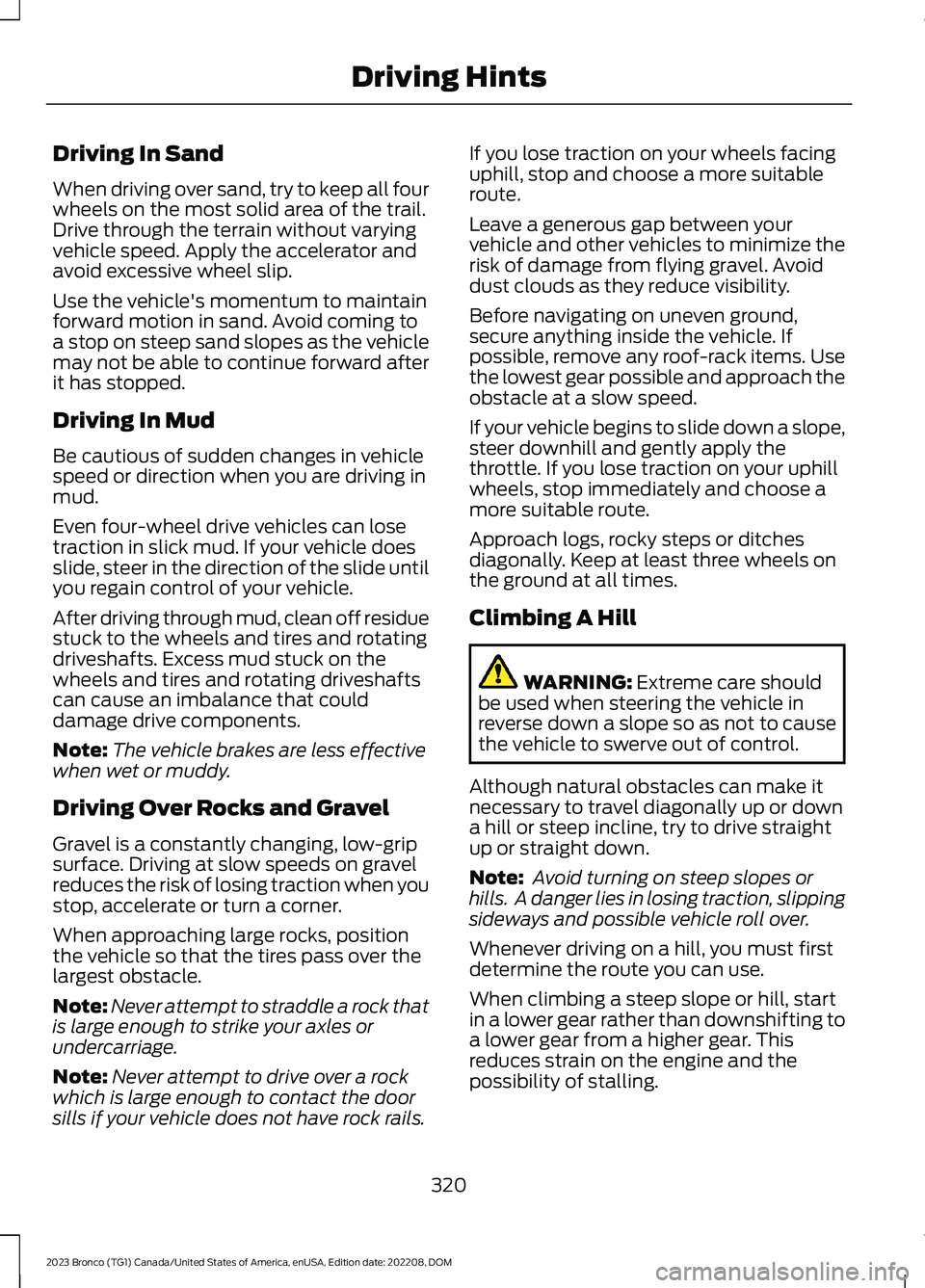
Driving In Sand
When driving over sand, try to keep all fourwheels on the most solid area of the trail.Drive through the terrain without varyingvehicle speed. Apply the accelerator andavoid excessive wheel slip.
Use the vehicle's momentum to maintainforward motion in sand. Avoid coming toa stop on steep sand slopes as the vehiclemay not be able to continue forward afterit has stopped.
Driving In Mud
Be cautious of sudden changes in vehiclespeed or direction when you are driving inmud.
Even four-wheel drive vehicles can losetraction in slick mud. If your vehicle doesslide, steer in the direction of the slide untilyou regain control of your vehicle.
After driving through mud, clean off residuestuck to the wheels and tires and rotatingdriveshafts. Excess mud stuck on thewheels and tires and rotating driveshaftscan cause an imbalance that coulddamage drive components.
Note:The vehicle brakes are less effectivewhen wet or muddy.
Driving Over Rocks and Gravel
Gravel is a constantly changing, low-gripsurface. Driving at slow speeds on gravelreduces the risk of losing traction when youstop, accelerate or turn a corner.
When approaching large rocks, positionthe vehicle so that the tires pass over thelargest obstacle.
Note:Never attempt to straddle a rock thatis large enough to strike your axles orundercarriage.
Note:Never attempt to drive over a rockwhich is large enough to contact the doorsills if your vehicle does not have rock rails.
If you lose traction on your wheels facinguphill, stop and choose a more suitableroute.
Leave a generous gap between yourvehicle and other vehicles to minimize therisk of damage from flying gravel. Avoiddust clouds as they reduce visibility.
Before navigating on uneven ground,secure anything inside the vehicle. Ifpossible, remove any roof-rack items. Usethe lowest gear possible and approach theobstacle at a slow speed.
If your vehicle begins to slide down a slope,steer downhill and gently apply thethrottle. If you lose traction on your uphillwheels, stop immediately and choose amore suitable route.
Approach logs, rocky steps or ditchesdiagonally. Keep at least three wheels onthe ground at all times.
Climbing A Hill
WARNING: Extreme care shouldbe used when steering the vehicle inreverse down a slope so as not to causethe vehicle to swerve out of control.
Although natural obstacles can make itnecessary to travel diagonally up or downa hill or steep incline, try to drive straightup or straight down.
Note: Avoid turning on steep slopes orhills. A danger lies in losing traction, slippingsideways and possible vehicle roll over.
Whenever driving on a hill, you must firstdetermine the route you can use.
When climbing a steep slope or hill, startin a lower gear rather than downshifting toa lower gear from a higher gear. Thisreduces strain on the engine and thepossibility of stalling.
320
2023 Bronco (TG1) Canada/United States of America, enUSA, Edition date: 202208, DOMDriving Hints
Page 330 of 642

Note:If you have removed the impactedmaterial from the wheels and your vehiclestill has a vibration check your vehicle fordamage or see an authorized dealer.
Inspect the exhaust system for damage orlooseness.
Make sure that the brakes are in properworking order and free of any mud, stonesand debris, which can become trappedaround the brake rotor, backing plate andcaliper.
Inspect the wheels for dents, cracks, orother damage.
Inspect undercarriage fasteners. If any areloose or damaged, tighten or replaceensuring that the proper torquespecification is used.
Inspect for torn or punctured boots on balljoints, half shafts, steering gears.
Refit the front license plate if removedpreviously.
COLD WEATHER
PRECAUTIONS
The functional operation of somecomponents and systems can be affectedat temperatures below approximately-13°F (-25°C).
BREAKING-IN
Your vehicle requires a break-in period. Forthe first 1,000 mi (1,600 km), avoid drivingat high speeds, heavy braking, aggressiveshifting or using your vehicle to tow. Duringthis time, your vehicle may exhibit someunusual driving characteristics.
DRIVING ECONOMICALLY
The following helps to improve fuelconsumption:
•Drive smoothly, accelerate gently andanticipate the road ahead to avoidheavy braking.
•Regularly check your tire pressures andmake sure that they are inflated to thecorrect pressure.
•Follow the recommended maintenanceschedule and carry out therecommended checks.
•Plan your journey and check the trafficbefore you set off. It is more efficientto combine errands into a single tripwhenever possible.
•Avoid idling the engine in cold weatheror for extended periods. Start theengine only when you are ready to setoff.
•Do not carry unnecessary weight in yourvehicle as extra weight wastes fuel.
•Do not add unnecessary accessoriesto the exterior of your vehicle, forexample running boards. If you use aroof rack, remember to fold it down orremove it when not in use.
•Do not shift into neutral when you arebraking or when your vehicle is slowingdown.
•Shut all windows when driving at highspeeds.
•Switch off all electric systems whennot in use, for example air conditioning.Make sure that you unplug anyaccessories from the auxiliary powerpoints when not in use.
326
2023 Bronco (TG1) Canada/United States of America, enUSA, Edition date: 202208, DOMDriving Hints
Page 388 of 642
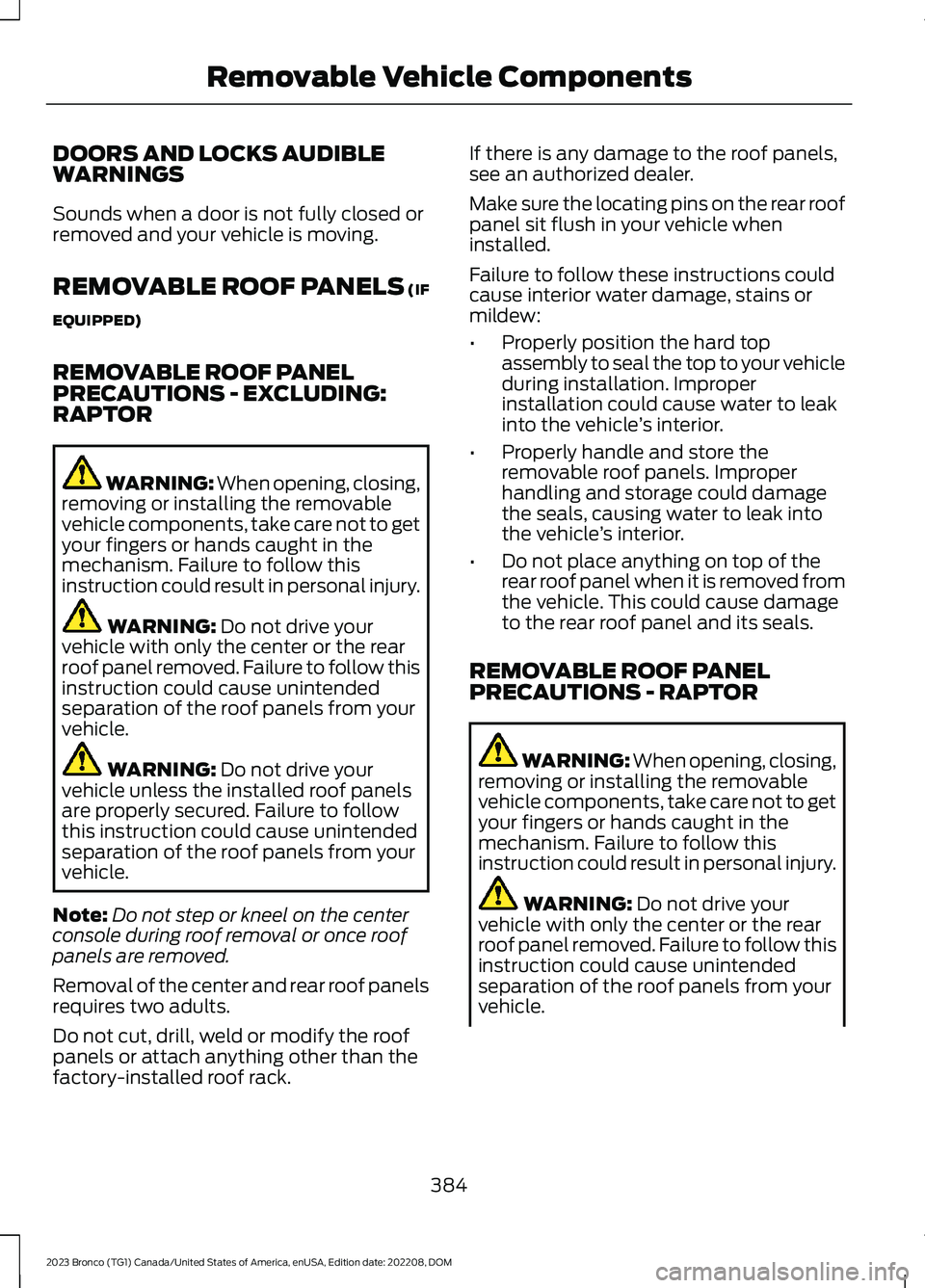
DOORS AND LOCKS AUDIBLEWARNINGS
Sounds when a door is not fully closed orremoved and your vehicle is moving.
REMOVABLE ROOF PANELS (IF
EQUIPPED)
REMOVABLE ROOF PANELPRECAUTIONS - EXCLUDING:RAPTOR
WARNING: When opening, closing,removing or installing the removablevehicle components, take care not to getyour fingers or hands caught in themechanism. Failure to follow thisinstruction could result in personal injury.
WARNING: Do not drive yourvehicle with only the center or the rearroof panel removed. Failure to follow thisinstruction could cause unintendedseparation of the roof panels from yourvehicle.
WARNING: Do not drive yourvehicle unless the installed roof panelsare properly secured. Failure to followthis instruction could cause unintendedseparation of the roof panels from yourvehicle.
Note:Do not step or kneel on the centerconsole during roof removal or once roofpanels are removed.
Removal of the center and rear roof panelsrequires two adults.
Do not cut, drill, weld or modify the roofpanels or attach anything other than thefactory-installed roof rack.
If there is any damage to the roof panels,see an authorized dealer.
Make sure the locating pins on the rear roofpanel sit flush in your vehicle wheninstalled.
Failure to follow these instructions couldcause interior water damage, stains ormildew:
•Properly position the hard topassembly to seal the top to your vehicleduring installation. Improperinstallation could cause water to leakinto the vehicle’s interior.
•Properly handle and store theremovable roof panels. Improperhandling and storage could damagethe seals, causing water to leak intothe vehicle’s interior.
•Do not place anything on top of therear roof panel when it is removed fromthe vehicle. This could cause damageto the rear roof panel and its seals.
REMOVABLE ROOF PANELPRECAUTIONS - RAPTOR
WARNING: When opening, closing,removing or installing the removablevehicle components, take care not to getyour fingers or hands caught in themechanism. Failure to follow thisinstruction could result in personal injury.
WARNING: Do not drive yourvehicle with only the center or the rearroof panel removed. Failure to follow thisinstruction could cause unintendedseparation of the roof panels from yourvehicle.
384
2023 Bronco (TG1) Canada/United States of America, enUSA, Edition date: 202208, DOMRemovable Vehicle Components